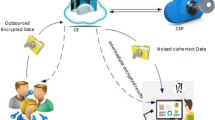Abstract
User privacy is an important concern that should be handled in data intensive applications. Interestingly, differential privacy is a privacy model that can be applied to such datasets. This model is advantageous as it does not make any strong assumption about the adversary. In this work, we have introduced the notion of differential privacy in the domain of Human Activity Recognition (HAR). Real life accelerometer data has been collected from different smartphone configurations that were carried by the users in different manner according to their convenience. Our contribution in this work is to propose a privacy preserving HAR framework incorporating algorithms to preserve the differential privacy of the user data. The algorithm exploits the scalar and the vector parts of the accelerometer readings and applies privacy preserving mechanisms on it. A Deep Multi Layer Perceptron (DMLP) framework has been utilized for activity classification. We have achieved comparatively similar results with an enhanced surplus of achievement of privacy in terms of data and are so far the first of its kind in the aforementioned domain of HAR based on smartphone sensing data. The proposed framework is implemented both on collected real life dataset capturing different smartphone configurations and usage behavior and benchmark datasets.








Similar content being viewed by others
References
Agarwal R, Hussain M (2021) Generic framework for privacy preservation in cyber-physical systems. In: Progress in advanced computing and intelligent engineering, Springer, pp 257–266
Boutsis I, Kalogeraki V (2013) Privacy preservation for participatory sensing data. In: 2013 IEEE International conference on pervasive computing and communications (PerCom), IEEE, pp 103–113
Clauset A, Moore C, Newman ME (2008) Hierarchical structure and the prediction of missing links in networks. Nature 453(7191):98–101
Dong S, Wang P, Abbas K (2021) A survey on deep learning and its applications. Comput Sci Rev 40:100,379. https://doi.org/10.1016/j.cosrev.2021.100379
Fredrikson M, Jha S, Ristenpart T (2015) Model inversion attacks that exploit confidence information and basic countermeasures. In: Proceedings of the 22nd ACM SIGSAC conference on computer and communications security, pp 1322–1333
Hu R, Guo Y, Li H, Pei Q, Gong Y (2020) Personalized federated learning with differential privacy. IEEE Internet Things J. 7(10):9530–9539
Hunter JD (2007) Matplotlib: A 2d graphics environment. Comput Sci Eng 9(3):90–95. https://doi.org/10.1109/MCSE.2007.55
Ji S, Mittal P, Beyah R (2016) Graph data anonymization, de-anonymization attacks, and de-anonymizability quantification: A survey. IEEE Communications Surveys & Tutorials 19(2):1305–1326
Kairouz P, Oh S, Viswanath P (2014) Extremal mechanisms for local differential privacy. Advances in Neural Information Processing Systems 4(January):2879–2887
Kasiviswanathan SP, Nissim K, Raskhodnikova S, Smith A (2013) Analyzing graphs with node differential privacy. In: Sahai A (ed) Theory of cryptography. Springer, Heidelberg, Berlin, pp 457–476
LeCun Y, Bengio Y, Hinton G (2015) Deep learning. Nature 521:436–444
Liu AX, Li R (2021) Predictable privacy-preserving mobile crowd sensing. In: Algorithms for data and computation privacy, Springer, pp 313–346
Pedregosa F, Varoquaux G, Gramfort A, Michel V, Thirion B, Grisel O, Blondel M, Prettenhofer P, Weiss R, Dubourg V, Vanderplas J, Passos A, Cournapeau D, Brucher M, Perrot M, Duchesnay E (2011) Scikit-learn: Machine learning in Python. J Mach Learn Res 12:2825–2830
Rojas R (1996) Neural networks: A systematic introduction springer. Berlin, Heidelberg. https://doi.org/10.1007/978-3-642-61068-4
Ryoo M, Rothrock B, Fleming C, Yang HJ (2017) Privacy-preserving human activity recognition from extreme low resolution. In: Proceedings of the AAAI conference on artificial intelligence, vol 31
Saha J, Chowdhury C, Ghosh D, Bandyopadhyay S (2020) A detailed human activity transition recognition framework for grossly labeled data from smartphone accelerometer. Multimed Tools Appl 1–22
Saha J, Chowdhury C, Roy Chowdhury I, Biswas S, Aslam N (2018) An ensemble of condition based classifiers for device independent detailed human activity recognition using smartphones. Information 9(4):94
Sahnoune Z, Aïmeur E (2021) Deloc: A delegation-based privacy-preserving mechanism for location-based services. Int J Mob Commun 19(1):22–52
Samarah S, Al Zamil MG, Aleroud AF, Rawashdeh M, Alhamid MF, Alamri A (2017) An efficient activity recognition framework: Toward privacy-sensitive health data sensing. IEEE Access 5:3848–3859
Shun Z, Benfei D, Zhili C, Hong Z (2021) On the differential privacy of dynamic location obfuscation with personalized error bounds. arXiv:210112602
Song C, Ristenpart T, Shmatikov V (2017) Machine learning models that remember too much. In: Proceedings of the 2017 ACM SIGSAC Conference on computer and communications security, pp 587–601
Stamate C, Magoulas G, Kueppers S, Nomikou E, Daskalopoulos I, Luchini M, Moussouri T, Roussos G (2017) Deep learning parkinson’s from smartphone data. In: 2017 IEEE international conference on pervasive computing and communications (PerCom), pp 31–40. https://doi.org/10.1109/PERCOM.2017.7917848
Sweeney L (2002) Achieving k-anonymity privacy protection using generalization and suppression. International Journal of Uncertainty, Fuzziness and Knowledge-Based Systems 10(05):571–588
Tran AT, Luong TD, Karnjana J, Huynh VN (2021) An efficient approach for privacy preserving decentralized deep learning models based on secure multi-party computation. Neurocomputing 422:245–262. https://doi.org/10.1016/j.neucom.2020.10.014. https://www.sciencedirect.com/science/article/pii/S0925231220315095
Vecchio A, Mulas F, Cola G (2017) Posture recognition using the interdistances between wearable devices. IEEE Sensors Letters 1(4):1–4
Wan S, Liang Y, Zhang Y, Guizani M (2018) Deep multi-layer perceptron classifier for behavior analysis to estimate parkinson’s disease severity using smartphones. IEEE Access 6:36,825–36,833. https://doi.org/10.1109/ACCESS.2018.2851382
Wang W, Zhang Q (2016) Privacy preservation for context sensing on smartphone. IEEE/ACM Trans Networking 24(6):3235–3247
Wolf FA, Hamey FK, Plass M, Solana J, Dahlin JS, Göttgens B, Rajewsky N, Simon L, Theis FJ (2019) Paga: Graph abstraction reconciles clustering with trajectory inference through a topology preserving map of single cells. Genome Biol 20(1):1–9
Zheng H, Hu H, Han Z (2020) Preserving user privacy for machine learning: Local differential privacy or federated machine learning? IEEE Intell Syst 35(4):5–14
Author information
Authors and Affiliations
Corresponding author
Ethics declarations
Conflict of Interests
The authors declare that there is no conflict of interest.
Additional information
Publisher’s note
Springer Nature remains neutral with regard to jurisdictional claims in published maps and institutional affiliations.
Rights and permissions
About this article
Cite this article
Garain, A., Dawn, R., Singh, S. et al. Differentially private human activity recognition for smartphone users. Multimed Tools Appl 81, 40827–40848 (2022). https://doi.org/10.1007/s11042-022-13185-4
Received:
Revised:
Accepted:
Published:
Issue Date:
DOI: https://doi.org/10.1007/s11042-022-13185-4




